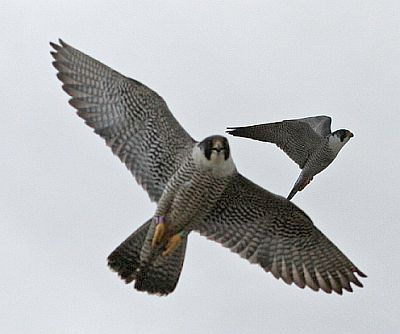 As you’ve probably noticed by now, raising baby peregrines is a full time job and it takes two parents to do it.
As you’ve probably noticed by now, raising baby peregrines is a full time job and it takes two parents to do it.
Dorothy and E2 at University of Pittsburgh are nearly at the end of this season’s work, but there’s more to come before they can rest.
Here’s what we’ve seen so far:
After Dorothy lays her eggs she incubates them for 33-35 days. E2 relieves her on the nest, but he supplies all the food. She doesn’t hunt much during this period. He does the hunting for two.
As soon as the eggs hatch, Dorothy broods the young and guards the nest. Her mate must then hunt for the entire family. A family of three or four chicks must be fed six to eleven times per day. This means E2 – with a little help from Dorothy – has to catch, kill and pluck 6-11 birds a day. He brings the prey to the nest and Dorothy usually does the feeding. This pattern of mother guarding the nest and father providing most of the food continues while the chicks are in the nest.
And in the next three weeks:
During the week before they fledge the chicks ledge-walk and fly-jump. They venture beyond the edge of the nest to walk the building ledges, flapping and jumping to various places.
The chicks also get rambunctious. Their parents stand back to avoid the craziness and they stop feeding them beak-to-beak. Instead they throw the prey to the chicks so they will figure out how to feed themselves.
When their parents think the chicks are ready to fly, they feed them less and demonstrate flight and food availability beyond the nest. This combination encourages the young to fly off the building (“fledge”).
As soon as a fledgling flies, his parents follow him and immediately bring him food if he landed in a safe place. If he landed in an unsafe area, his parents use food to entice him to come to a safe zone.
Now the parents’ jobs are even harder. They must hunt for food and deliver it to chicks who are scattered in a variety of places. This phase doesn’t last long. Soon the chicks figure out they can chase their parents to get food. The parents turn the chases into lessons in how to hunt.
Soon after the hunting lessons, the parents back off and make themselves scarce during the day so the young will hunt for themselves. This doesn’t prevent the young peregrines from waiting for their parents to return home at night. When they see their parents approaching from a distance they wail and fly toward them, hoping for a handout. Sounds like teenagers, eh?
Eventually – as soon as early July – the young peregrines leave Pittsburgh to start life on their own. Another nesting season ends. Dorothy and E2 can rest.
Thanks to Chad and Chris Saladin for permission to use their picture of Stammy and Stellar flying together in Youngstown, Ohio.
p.s. 9:00am, June 5: This morning I stopped by Schenley Plaza after the thunderstorms passed. E2 brought in a pigeon for breakfast – it was still alive. He landed next to two of the chicks and then killed the pigeon while the chicks watched intently. I guess today’s peregrine lesson was “Here’s how you kill a pigeon.”
Do the parents stay together all year or do they go their own way and then reunite for mating season?
In temperate zones where there’s enough food (here, for instance) the adult peregrines stay on territory all year – which means they stay together. One of them may leave for a week or two but they come back very soon because the territory is too valuable to lose.
I saw your posts this morning on The PA Birding List and went to your blog. I don’t have my spotting scope with me today but will try to bring it and my digiscope tomorrow so that I can join you for the evening watch. Please e-mail me with any questions.
A friend and I stopped by the Plaza at lunchtime (~ 11:45 ’til almost 12:30). I forgot the binoculars, but we still saw a display of flying around the Cathedral early on – probably E2 – and then a few instances of running-and-flapping along the ledge. Exciting!
Wow, it’s amazing how fast the chicks grow. The 3 at Pitt actually share my birthday. I was just curious if you know anything about Bo and Shenandoah on the 62nd street bridge. Did they have any success this year now that they have a nest box?
Alas, Bo and Shenandoah did not nest this year. The 62nd Street Bridge is under construction and the jack-hammering and human activity was just too much for them even though they had a nest box. Maybe they’ll come back next year, but it the bridge will have to be quiet like it was last year.